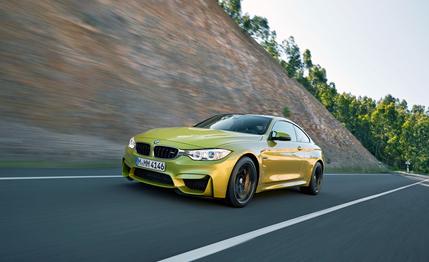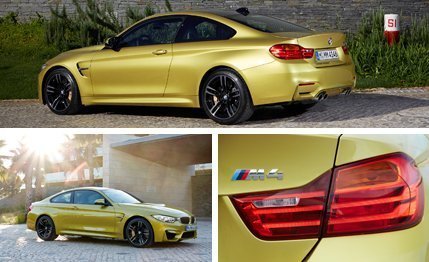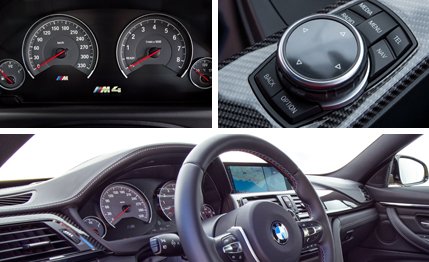 First Drive Review
First Drive Review
Until now, manual-transmission versions of the 2015 BMW M3 and M4 have eluded our collective left foot. We were beginning to think BMW was going to delay the release of the manual or possibly pull the plug altogether. After all, some other brands have taken their respective performance models automatic only. Now that we’ve finally driven the manual F82 M4, we can say it not only exists but is also good.
In an enormous effort to make the new, slightly more powerful (up from 414 horsepower to 425) M4 lighter than the previous-generation M3 coupe, the car went on a crash diet. Aluminum is used for the hood, fenders, and various suspension pieces. The roll call of weight saving drones on like a boring financial report: a magnesium oil pan (minus two pounds versus a 335i), a plastic-skinned carbon-fiber trunk (11 pounds saved), a carbon-fiber driveshaft (minus 12 pounds), a new 3.0-liter engine-block design (five pounds saved), optional carbon-ceramic rotors (subtract 16 pounds). The result is a car that BMW claims weighs 180 fewer pounds than the E92 M3 coupe. And it’s anything but boring.

Working the Pedals
Driving the manual M4 smoothly takes more skill than is required to pilot the dual-clutch automatic. Every time you disengage the clutch under full throttle, thrust is interrupted. But because the new turbocharged engine’s 406 lb-ft of peak torque occurs over a wide band from 1850 to 5500 rpm, it’s easier to manage than before. The old M3 was very much a screamer, the naturally aspirated V-8 making max power at its heady 8300-rpm redline and a maximum of 295 lb-ft at a relatively lofty 3900 rpm. By contrast, the turbocharged M4 makes maximum power in a broad swath from 5500 to 7300 rpm, 200 rpm shy of the redline.
BMW modified the 1-series M six-speed manual for service in the new M4, adding a twin-plate clutch and improving the synchros. Shifter action is smooth, and the throws are short without too much effort. BMW added a rev-match function that works in Sport or Efficient mode, but driving in Sport Plus mode still requires some heel-and-toe maneuvers to make a clean downshift. The brake pedal contributes to easy shifting, too. Its travel is short, and there isn’t a hint of a dead spot at the top. Braking force builds in lockstep with pressure, and the accelerator pedal is never too far from the brake pedal to blip the throttle.
Michelin Pilot Super Sports, on 18- or 19-inch ($1200) wheels, are the foundation for braking and lateral performance. But as good as they help the brakes feel, the tires don’t make up for the steering degradation compared with the old M3. There is decent effort buildup in corners, but feedback is lacking overall. There is a faint effort drop as understeer takes over.

Even with the slightly lower weight, we don’t anticipate a big improvement in acceleration times with the manual transmission compared with those of the E92 M3. Expect the 60-mph sprint to take about 4.2 seconds and the quarter-mile dash to occur in about 12.4. We’ll know better when we get our mitts on one for instrumented testing.
One of the best things the manual has going for it is the cost. A bone-stock M4 with cloth seats (the way to go, in our opinion) costs $65,125, although it isn’t hard to reach $80,000 with options. Going three-pedal saves the $2900 BMW charges for the optional seven-speed dual-clutch automatic, and neither stick- nor DCT-equipped M4 carries a gas-guzzler tax, as did the old car. Opting for a manual-transmission M4 is a clutch move in our book—less costly to purchase and about as much fun as you can have with three pedals and a stick.